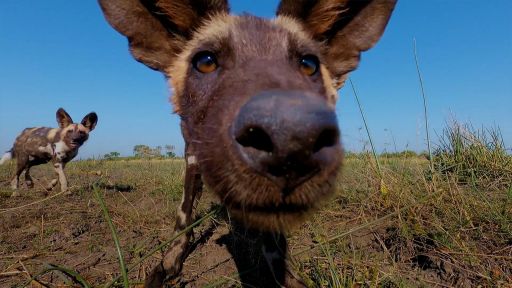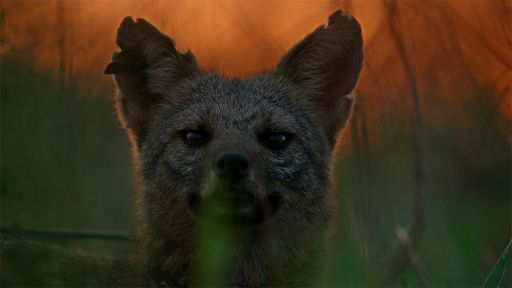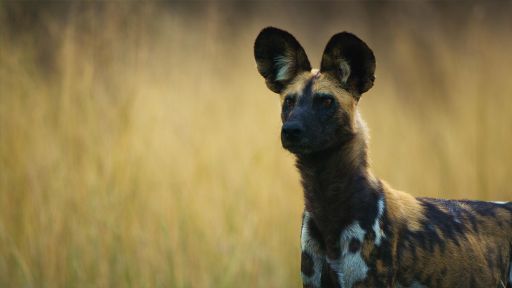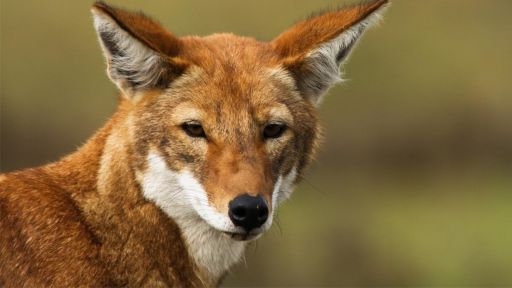TRANSCRIPT
♪♪ NARRATOR: The Arctic fox.
A supreme survivor.
♪♪ Just one of an incredible animal family.
The canids.
37 faces... ♪♪ ...including wolves... foxes... jackals... and dogs.
♪♪ Found in almost every habitat on Earth... [ Yelping ] ...from the frozen Arctic... [ Howling ] ...to the blistering desert... ♪♪ ...from the treetops... ...to the heart of the city.
♪♪ Each with a unique strategy for survival.
They are intelligent, resourceful, and remarkably resilient.
Meet the dogs in the wild.
[ Animal howl echoes ] ♪♪ ♪♪ ♪♪ NARRATOR: Stretching as far as the eye can see.
The Kalahari Desert -- Botswana, Africa -- is home to one of the most opportunistic wild dogs.
♪♪ The black-backed jackal.
♪♪ [ Howling ] They may look similar to foxes but are actually more closely related to wolves.
[ Howling ] It's the end of the dry season.
In some areas, no rain has fallen for eight months.
Water is scarce, and the Kalahari is living up to its name -- "The Great Thirst."
But this group of jackals lives close to a vital lifeline.
This waterhole is a rare treasure that attracts visitors from far and wide.
♪♪ ♪♪ It can get a little crowded.
♪♪ ♪♪ Not only is it a crucial source of water, it's also a prime hunting ground.
[ Snorting ] ♪♪ Most visitors are too big for the jackals to bring down.
♪♪ But these agile predators are opportunistic... ♪♪ ...always on the lookout for any chances that might come their way.
♪♪ Every day, flocks of ring-necked doves, sparrows, quelea, and sand grouse come to drink.
Some fly in as far as 50 miles.
A tempting meal... if you can get to it.
♪♪ ♪♪ The jackals rely on speed and agility.
♪♪ The flock takes flight at the first sign of danger.
♪♪ ♪♪ ♪♪ But these jackals are fast.
One dove lags behind.
♪♪ ♪♪ A very lucky escape.
♪♪ Now another opportunity -- a flock of guineafowl.
♪♪ [ Guineafowl calling ] ♪♪ ♪♪ It's the breeding season, and they're distracted by the competition to find a mate.
♪♪ ♪♪ A deadly mistake.
♪♪ ♪♪ A hard-earned prize.
But this meal will be shared.
♪♪ These jackals are part of a family.
♪♪ [ Pups yelping ] And there are some new arrivals.
♪♪ At around six weeks old, these pups are beginning to feed on solids.
Black-backed jackals often live in close-knit family groups where everyone has a part to play.
♪♪ Last year's pups still live with their parents and help to provide for their younger siblings.
♪♪ And together they use their extraordinary skill and agility to feed the pups throughout the toughest times, giving them the best start in life.
The canid family have many tricks up their sleeves, enabling them to survive in the most extreme environments, from the hottest... [ Wind rushing ] ...to the most bitterly cold.
Winter on the edge of Hudson Bay, Canada.
Temperatures have plummeted to a numbing 16 below zero.
Only the strongest survive these bitter conditions.
♪♪ Polar bears, the largest land predators, prowl the tundra.
But there's another formidable, somewhat smaller hunter who stalks this frozen landscape.
♪♪ ♪♪ The Arctic fox.
♪♪ Perfectly hidden against the snow, they are uniquely adapted to thrive in the frozen north.
♪♪ Their winter coats not only provide the perfect camouflage, but also incredible insulation.
♪♪ Trapping heat close to the body, this is the warmest coat found on any wild dog.
♪♪ Even the soles of their feet are protected by a thick layer of fur.
♪♪ But even in a warm coat, finding food in these bitter conditions is a challenge.
[ Animal calling ] Later in the season, when the sea freezes over, they'll follow polar bears out onto the ice and scavenge all their kills.
But for now, they're stuck on land, and the foxes are forced to fend for themselves.
♪♪ ♪♪ Arctic foxes are solitary hunters, traveling around 50 miles a day in search of food.
♪♪ ♪♪ Yet some of the best prey may be nearby... but completely out of sight.
Impeccable hearing allows the fox to locate small rodents such as lemmings scuttling beneath the surface.
[ Snow rustling ] [ Rapid footsteps ] [ Sniffing ] ♪♪ ♪♪ Diving headfirst, they break through the frozen layer of snow.
♪♪ ♪♪ Sometimes even the best hunters miss their mark.
But in the big freeze, a fox must still feed.
A flipper from a seal carcass -- a rare prize packed full of calories.
A find like this soon attracts unwanted guests, and this Arctic fox has no interest in sharing.
♪♪ ♪♪ [ Foxes yelping ] But for the loser, all is not lost.
Because the secret to the Arctic foxes' success is their flexibility.
♪♪ Hidden in the snow and kept fresh in the freezing conditions, these juicy lingonberries -- similar to cranberries -- are packed with energy.
A lifeline for a hungry fox.
♪♪ ♪♪ This remarkable ability to vary their diet allows these plucky predators to survive the bitter winter and truly conquer these frozen lands.
♪♪ Thriving in a hostile environment is particularly tough when raising a family.
Stretching across the center of North America is a sea of grass.
These open plains cover over a million square miles, from Canada in the north to the most southerly states of the USA.
This prairie habitat is one of the largest of its kind in the world and is home to one of the smallest wild dogs in North America.
♪♪ The swift fox.
[ Sniffing ] This female is around the size of a housecat and has recently become a mother of four tiny kits.
♪♪ But she's been dealt a bitter blow.
Her mate has disappeared and has likely died.
So now it's up to her to keep her young family safe.
♪♪ ♪♪ Being so small, she and her kits make an easy target for larger predators such as coyotes and eagles.
♪♪ And on the flat, open prairie, these foxes are left exposed with little protection.
However, this family has a subterranean safe house.
♪♪ All wild dogs use dens when raising a family... but the swift foxes rely on theirs all year round.
♪♪ Several entrances provide plenty of routes to safety three feet underground.
This underground home also provides the foxes with protection from the harsh sun.
♪♪ ♪♪ Being so dependent on their den for survival, the female must ensure it's kept in tiptop condition for.
♪♪ With the pups distracted, Mom gets to work.
♪♪ ♪♪ Entrances must be kept clean... and clear.
♪♪ But there are always some things that are hard to part with.
♪♪ The remnants of a kill make an excellent toy.
♪♪ With the housework done, Mom must ensure her territory is secure.
Leaving the pups is a risk, but this work is vital.
Masking her scent by picking up the odor of other animals that have passed by, she reduces the risk of predators detecting her smell and finding her den.
♪♪ Back at home, the pups are also hard at work.
♪♪ Playing helps them develop their strength, coordination, and hunting skills.
♪♪ ♪♪ [ Yelps ] ♪♪ And when their mother returns from her duties... ♪♪ ...even she takes a moment to play.
♪♪ ♪♪ Thanks to their den and their hardworking single mom, the future looks bright for this new generation.
[ Animals calling ] In Africa lives one of the most successful hunters in the world.
The African wild dog.
♪♪ It lives in the Okavango Delta, one of the world's largest wetlands.
Over 2 trillion gallons of water flow through the delta every year.
♪♪ During the dry season, it provides a haven for many of Africa's iconic species.
♪♪ These dogs face a tough existence, living amongst other larger predators such as lions... and leopards.
♪♪ On their own, they are destined to fail.
♪♪ But one of the keys to their success is family.
African wild dogs find strength in numbers, and of all the wild dogs across the world, these are the most sociable.
♪♪ This family is known to scientists as the Ninja pack.
They're part of the longest large-predator research project in Botswana.
Made up of four adults, the pack has a strict hierarchy.
The most dominant male and female are the joint heads of the family.
They form the alpha pair and are usually the only ones to breed.
For the Ninja pack, It's been a good year.
[ Pups yelping ] With seven new boisterous pups, the family has tripled in size.
The youngsters are growing fast and are more demanding than ever.
To provide enough food for the entire family, the pack needs to hunt.
For the youngsters, the urge to hunt is inbuilt.
♪♪ And they are keen to practice.
♪♪ Passing warthogs are a tempting target.
♪♪ ♪♪ But they still have a lot to learn.
♪♪ [ Warthog grunts ] [ Bird screeches ] Hunting takes an adult's experience.
But with temperatures soaring above 85 degrees in the middle of the day, it's too hot.
[ Panting ] The pack has no choice but to find shade.
[ Insects buzzing ] And so they rest...and wait.
Their coats, much like our fingerprints, are unique to each dog and may also help camouflage them.
[ Snoring ] [ Elephant groaning ] [ Branches snapping ] Out here in the bush, with noisy neighbors, the peace never lasts long.
♪♪ And a family of rhinos is enough to get the pack moving.
♪♪ The dogs quickly turn their attention to food.
♪♪ A herd of buffalo.
They're far too big for one dog to take on alone and could easily kill a single wild dog.
♪♪ If they are to eat, they need the whole pack.
But how does a group of 11 dogs make the decision that now is the right time to hunt?
[ Dogs yelping ] The secret is a pre-hunt rally.
[ Dogs yelping ] The whole pack performs high-energy, almost playlike behavior -- the dog version of a pre-match huddle, getting each family member in sync and fired up.
[ Dogs yelping ] But scientists studying the Ninja pack and other wild dog packs in the Okavango have discovered something even more intriguing.
♪♪ Just before and during a rally, the dogs begin to sneeze.
[ Sneezing ] There are several theories as to why the dogs do this, but one study suggests it could, believe it or not, be a complex voting system.
[ Sneezes ] If there are enough sneezes, the pack will be more likely to move off and hunt.
If not, they will stay and rest.
♪♪ Sneezing completed... the decision is made.
The hunt is on.
♪♪ African wild dogs can cover over six miles a day in search of food.
♪♪ A herd of impala.
♪♪ The pack sets off in pursuit, led by the subordinate female.
♪♪ ♪♪ [ Animals calling ] And working together, they've made a kill.
[ Insects buzzing ] Each dog eats around 11 pounds of meat in a single sitting.
Nothing goes to waste.
♪♪ Finally, bellies full, they can rest.
♪♪ Providing for a family can take a whole pack.
♪♪ But for another wild dog, all it needs... is the perfect partner.
♪♪ This is the largest savanna in South America, the Cerrado.
Covering nearly a quarter of Brazil, it's made up of grasslands, forests, and swamps... and, increasingly, agricultural land.
10% of all Brazilian species are found here, including a wild dog that is seen nowhere else on Earth.
The small-toothed dog, or the hoary fox.
♪♪ This male is known to scientists as Peter.
♪♪ He's part of a research population and has recently paired up with this female, Kraho-Kanela.
It's the breeding season, and the strength of this new partnership is key if they are to successfully raise a family.
♪♪ As darkness falls, the pair begins the night shift.
Around five weeks ago, Kraho-Kanela gave birth to four tiny pups.
Since then, she's spent much time away from the den... ...only returning to suckle her young.
But her absence is critical to her pups' survival.
To produce enough milk, she must eat.
In some wild dog species, males bring food to the female.
But because around 80% of the small-toothed dog's diet is made up of insects which can be found close to her den, the best way for Kraho-Kanela to get enough food is to find it herself.
With Mom occupied, Dad picks up the slack... ♪♪ ...keeping a watchful eye on the pups as they begin to explore their surroundings.
♪♪ They're learning early that feeding on insects can be a bit, well... tricky.
♪♪ ♪♪ ♪♪ And sometimes the neighbors get in the way.
♪♪ [ Sniffing ] But it's a skill they need to master, and fast.
[ Animal growls in distance ] At this time of year, there's an abundance of food the pups must learn to take advantage of.
Termites.
Just after the first rains of the season, something known as a revoada occurs.
Thousands of male and female winged termites emerge for their annual nuptial flight.
♪♪ Peter steps in to show the pups how it's done.
♪♪ His small muzzle contains specialized, broadened molars which allow him to crush the tough insects.
♪♪ ♪♪ Mimicking their dad, the pups quickly get a taste for this new delicacy.
♪♪ This is a key lesson for the pups.
They're fast learners.
♪♪ But for some, it's all been a bit too much.
[ Snorts ] Peter has proven to be an excellent father.
However, parenthood is taking its toll.
He's losing weight and condition.
But his strong, new partnership with Kraho-Kanela has ensured this breeding season has been a success.
For some wild dogs, it's the power of the pack that's the key to their success.
♪♪ The Ethiopian Highlands.
Nearly 15,000 feet above sea level.
These towering mountains are known as "The Roof of Africa."
♪♪ Living here is a challenge.
Temperatures can fluctuate by 74 degrees in a single day.
♪♪ This habitat is unique.
Many of the species who live here are found nowhere else on Earth.
♪♪ That includes one of the most threatened of all wild dogs.
The Ethiopian wolf.
♪♪ Restricted to small pockets of the highlands above the tree line, these wolves are thought to descend from an ancestor similar to the gray wolf that arrived in Africa from Eurasia 100,000 years ago.
[ Wolves yelping ] They live in a large, close-knit family.
This pack has some new arrivals.
Their mother is almost certainly the dominant female, but all members of the family will help with childcare, from regurgitating food... to babysitting... even being a jungle gym.
However, raising a family is not the only reason Ethiopian wolves live in such strong packs.
It also gives them a key advantage when it comes to finding food.
♪♪ Every day, the pack sets off to hunt.
♪♪ But each wolf breaks away to search for food alone.
♪♪ ♪♪ Here in the Highlands, the wolf's staple diet is rodents.
They are everywhere.
♪♪ Grass rats make a tasty meal.
[ Squeaking ] But they live in a colony and are hypervigilant.
[ Squeaking ] ♪♪ An easier meal can be found in the bigger, juicier giant mole rat.
♪♪ Living alone, these unusual-looking rodents rarely stray far from the safety of their burrows.
♪♪ The wolves employ a range of tactics to get to the mole rats.
♪♪ Some try digging them out.
Others use their long, slender muzzles to reach into the burrow... ...which isn't always successful.
Patience is required.
Eventually the mole rat can't resist a leaf just out of reach.
[ Squeaking ] Lunch at last.
Ethiopian wolves are highly skilled hunters, but they also go to great lengths to secure the best hunting grounds.
Mole rats only live in specific areas of the Highlands.
So the wolves must unite to protect their hunting rights and work together.
♪♪ Every day, the pack congregates and sets off to patrol their territory, leaving scent marks to ward off other neighboring packs.
[ Urinating ] ♪♪ The larger the pack, the better chance they have of holding the best territory.
♪♪ This is important now, more than ever, as the wolf's habitat is shrinking.
♪♪ Increasingly, these mountains are being used for farming.
Today, 60% of the wolf's habitat has been converted to subsistence agriculture, putting ever more pressure on the wolves.
♪♪ [ Yelping ] Less than 500 Ethiopian wolves remain in the wild.
[ Yelps ] The fate of each and every one is critical.
Living alongside humans creates challenges, but sometimes it also creates opportunities.
In a backyard in Austin, Texas, nature has been left to reclaim its territory.
And over time, it's created a new secret oasis... ♪♪ ...for one of the most nimble wild dogs.
♪♪ This is the gray fox.
♪♪ They're usually found in woodland.
This secret garden of thick brush is the ideal substitute home and perfect for raising a family.
At around two and a half months old, these kids have spent most of their lives underground in the safety of their den, but now they've grown over 10 times in size and they're almost indistinguishable from their mother.
♪♪ Play is the beginning of the kits' journey to learning key life skills.
♪♪ But to survive here, there's an essential thing every young gray fox must master.
The gray fox has retained an ancient talent lost by almost all of their wild dog cousins.
They can climb.
♪♪ ♪♪ For the kits, the urge to climb comes naturally.
♪♪ But they have a lot to learn.
♪♪ ♪♪ [ Yelping ] ♪♪ Luckily, they're born with the right tools for the job.
♪♪ This short legs and long tail give them exceptional balance.
♪♪ Semi-retractable claws and the ability to rotate their forearms provide them with excellent grip.
♪♪ And, of course, practice makes perfect.
♪♪ They spend the summer honing their skills.
And by the autumn, these canid climbers can navigate the highest branches... even in the dead of night.
[ Fox howls ] ♪♪ Here in the heights, gray foxes hunt roosting birds.
♪♪ But the canopy offers safety, too.
Even in this back garden, danger lurks in the shadows.
♪♪ A coyote.
♪♪ Given the chance, they'd readily kill a gray fox.
♪♪ [ Fox howls ] But by mastering this ancient skill, these kits have conquered one of the most unusual habitats for wild dogs and are ready for life at the safety of the trees.
[ Fox barks ] Thriving in the suburbs may be a challenge... but there's one wild dog that has found sanctuary in the heart of the city.
[ Engine revs ] [ Horns honking ] Tokyo.
The most populated metropolis in the world.
♪♪ 38 million people call this home.
♪♪ The constant bustle is an assault on the senses.
♪♪ This world created by humans is also home to a growing population of legendary wild dogs.
♪♪ Statues of them can be found across Japan.
Legends dating back over 800 years say they hold supernatural powers and can trick unsuspecting humans.
Shying away from the bright city lights, they inhabit the shadows of the night.
[ Animal growls ] This is the tanuki... ♪♪ ...otherwise known as a raccoon dog for its strong resemblance to its namesake.
♪♪ Japanese tanukis are usually found in forests and meadows.
♪♪ But these tanukis have found an oasis in the city.
♪♪ Scattered amongst the high-rise buildings are pockets green, like this Buddhist temple garden which provides the perfect secret sanctuary.
And over the last 30 years, numbers of tanukis have been increasing.
Unlike many wild dogs, urban tanukis aren't usually territorial.
Their home ranges overlap with their neighbors, allowing them to share the best city habitats.
But when you live so close together, knowing what the neighbors are up to is key.
[ Animals calling ] Night-vision cameras allow us to follow tanukis into the darkest corners.
And hidden beneath the temple is the secret to their success.
A communal tanuki toilet.
♪♪ This is not just a convenient spot for a pit stop.
Unlike most wild dogs who scent-mark to ward off others, tanukis appear to use these sites to maintain their friendly neighborhood.
Glands on the base of their tails and on their rear ends add a rich mix of scent to the pile.
And each tanuki has its own unique smell.
♪♪ ♪♪ Like all wild dogs, tanukis have incredibly sensitive noses.
♪♪ When other tanukis visit, they can tell who's been here before them and when... before leaving their own calling card.
♪♪ Knowing their neighbors' movements may help tanukis maintain a mutual tolerance of each other.
This could be especially useful in the city where urban tanukis live in higher densities than their countryside cousins.
♪♪ [ Animal chittering ] These sites may also act as a community message board, allowing tanukis to exchange other information such as reproductive status and even what they've eaten.
♪♪ The temple provides a diverse menu, including fruit, flowers, and insects.
♪♪ But also a gourmet meal has been prepared.
Every evening, food is laid out for the tanukis.
♪♪ By living alongside one another, sharing information, and taking advantage of their relationship with humans, these tanukis can prosper in their new urban home.
♪♪ [ Engine revs, horn honks ] ♪♪ ♪♪ Wild dogs' amazing adaptability has allowed them to live across the globe in some of the most extreme and remote environments... ♪♪ ...and even alongside humans.
♪♪ However, in this ever-changing modern world, they face new challenges and threats.
♪♪ Nearly 30% of all wild-dog species are either near threatened or threatened with extinction.
[ Yelps ] But there is hope.
If this incredible family is to continue to thrive, they need space... and new ways to live alongside their biggest threat... ...us.
Next time, meet the passionate people... WOMAN: One of the most beautiful species on Earth.
NARRATOR: ...who are on the frontline of discovery... MAN: Look.
There it is.
NARRATOR: ...closer than ever before... WOMAN: This is pup two.
NARRATOR: ...to the canids.
MAN: Just a beautiful gift of the nature.
♪♪ ♪♪ ♪♪ ♪♪ To learn more about what you've seen on this "Nature" program, visit pbs.org.
♪♪




